Chapter 24 Hard Times
 aving met Edward (1737.46) and Mary Caldecott in part three, chapter 17, we can follow their children.
aving met Edward (1737.46) and Mary Caldecott in part three, chapter 17, we can follow their children.
Edward, you will remember, had a traumatic childhood. Born with a disadvantage,330 the situation seems to have worsened when his mother died during his fifth year - he clearly had a personality clash with his step mother. This seems to have led to turbulent teenage years and, if it did not lead to a rebellious life it certainly seems to have affected his ability to handle money and personal relationships. Moving out from the family into lodgings in Barrow, and into a factory woolcombing job. He married Mary Caldecott who was five months pregnant on her wedding day. It may have been the woolcombers strike or just plain redundancy that made them move back to Tuddenham for a while. The first three children were baptised in Tuddenham, then, sometime between 1780 and 1782 they moved to Wivenhoe where George was born.
The behaviour pattern of his six children suggests a stormy marriage and home life. The daughters of Edward (1737.46) were reasonably well educated and Ann married well, Perhaps under the watchful eye of grandparents at Tuddenham.
Sarah(1772.50) , baptised 12th January 1772 Barrow, remained a spinster all her life. She also remained close to her parents as they moved around the country probably keeping a watchful eye on then as daughters do. She was not provided for under the parish poor fund with the rest of the family and there is a hint that she learned a trade in dressmaking - later owning a ladies dress shop in Colchester331 My hunch is that there is a connection between Sarah and her cousin William Lymmer who was now running the Lymmer clothing factory332 of Colchester. Between them I surmise they provided some cottage industry for Edward, and that would account for the money listed for John's parcel deliveries to Colchester every so often333. Sarah(1772.50) was buried Colchester 1843.
Lucy(1774.50) Limmer was baptised 5th November Tuddenham. She later married John Taylor and moved to Southampton.
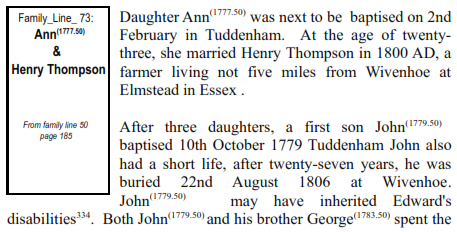
next four or five years of their life on the poor register of Wivenhoe with their mother. According to the amended workhouse law, able-bodied people of fourteen and over were to apply to workhouses in their own right.
By the time John(1779.50) was fourteen, he had developed the nature of a willing and useful lad. At twelve, a young healthy male would have been expected to be out at work but John was still regularly making trips as an errand boy, probably collecting and delivering cloth.335. John’s father, Edward(1737.46) 336 who, probably for health reasons had turned his hand to other skills in the clothing trade. The 6d for round trips fair recorded in the poor house records are for runs between Wivenhoe and Colchester. These were paid regularly between 1798 and 1799. ‘Old Limmer’ (Edward), seems to have set up in tailoring from his terraced cottage in Wivenhoe337.
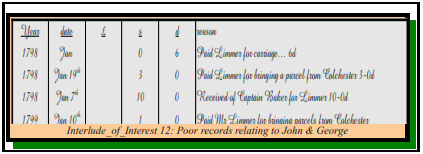
My guess is that John(1779.50) was running errands between Edward(1737.46) and William Lymmer who, by then, had inherited the cloth and clothing factory in Colchester338. William signed his signature as master to several apprentices around this time, among them were: Peter Motteux, William Nickless, and a young lady named Elenor Amyion.339
John(1779.50) was twenty one when records of monitory assistance by the poorhouse suddenly cease. Whether he was delivering goods for his father or going to visit his relatives in Tuddenham that August day in 1806 will remain a mystery340. Just one year after the death of her husband Edward(1737.46), Mary suffered another blow with the death of her son John(1779.50). John (1779.50) mounted the bar on top of a stagecoach and four, bound from Colchester to Suffolk that morning. Officially, the bar of the stagecoach was for luggage but “everyone did it”; especially the poor who needed to travel third class. Barely twelve miles from home, the axle of the coach gave way and John, thrown from the stagecoach, was crushed. The inquest on the 27th August 1806 was inconclusive but John's burial was not paid by parish but by the coach company. John(1779.50) died in 1806341.
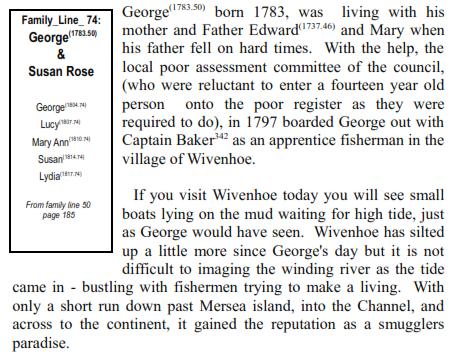
George met a young lass named Susan Rose from the next village.
Her folks were fishmongers and I can imagine them meeting at the water's edge as Susan bought fish from Captain Baker. Walking at a good pace along the well worn footpath by the river bank, then across two fields, George could reach Susan's house in three-quarters of an hour.
The year 1803 became a year of mixed blessings for George. At the age of twenty, first he saw his father’s health deteriorate rapidly from January until he died in April, then George(1783.50) married Susan Rose on the 8th November 1803 Thorrington (Essex) by licence. Four months later, George(1804.74) junior was born on 11th March 1804 Wivenhoe. Uncle John(1779.50) would have seen his new nephew George(1804.74) before his fatal accident on the stagecoach, but Edward(1737.46) did not survive to see either his son's wedding or his grandson.
At the age of twenty-one, George(1783.50) collected his indentures and applied his hand as a merchant seaman for a while.
Hard times had not yet ended yet for George(1783.50) and his family. August 1806 not only saw the stagecoach accident of his brother but also the beginning of another set of bad circumstances. I am more incline to think of George as a victim than a renegade in what followed.
Merchant seamen hit upon hard times as Napoleon gained the support of Germany and ring-fenced Europe blockading British trade. George(1783.50) seems to have survived this blockade having just signed up as crew member on the new American trade routes which were now opening. Still, the family struggled on the best they could. The longer runs to America meant the pay check did not always arrive on time and when it did the money was quickly gone.
So by 1822 George(1783.50) and his family have to turn again to the poor fund of Wivenhoe. Sometimes out of work and sometimes because the pay cheque had not arrived, the poor accounts document a second generation of Limmer, struggling to make ends meet.343
The children of George(1783.50) and Susan have three and four year gaps between them, adding weight to the suggestion that George stayed on the American trade route right through the French hostilities toward Britain in 1812, and on through the passing of the slavery act forbidding slave transportation and finally through the Luddite uprising in England. All of these took toll on merchant shipping.
Daughters Lucy(1807.74) born 29th August 1807 Wivenhoe and Mary-Ann(1810.74) born 26th October 1810 Wivenhoe would have hardly seen their father in all this time. The year third daughter, Susan, was born marked a turn of fortune. Susan(1814.74) born 20th November 1814, the year the European blockade ended. Britain signed two trade agreements, one with America and another with the Dutch.
Susan(1814.74), born in Wivenhoe, grew up to live a life as a spinster dying in 1868 Stepney at the age of fifty-four. As a mark of these better times she was able to hold down a job most of her life and leave a little money. Fourth daughter, Lydia(1817.74) Limmer was born 6th June 1817 Wivenhoe.
George(1804.74)was the first son of George(1783.50), and Susan. Born the year after his grandfather died, 11th March 1804, George grew up on the rough side of Wivenhoe renown for its smuggling, drunkenness and riots.
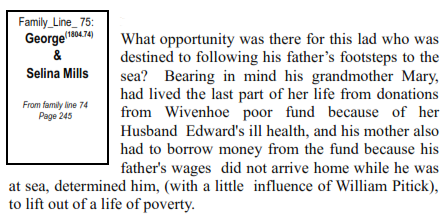
At the age of 15, the local poor council stepped in 344 to find George(1804.74) an apprenticeship agreement with fisherman William Pitick. The papers were signed in 1818 and George(1804.74) moved out from home and under the care of William Pitick who lived a few roads away in a cottage overlooking the estuary. George was clearly under a better influence now, he served his seven year apprenticeship then continued to work for William.
As things were better internationally, George was able to hold down an almost uninterrupted period of employment and being a thrifty young man, he was able to save enough to buy a house on the better side of the water. At the age of thirty years, he married Selina Mills on the 13th December 1834 at St. Martins Church Colchester. Selina, born 1815, was only nineteen at the time.
The house he managed to buy in West Street, 345 on the opposite side of the river to his parents, was a two up two down town house in a narrow road with the front door opening straight onto the road. George(1804.74) and his wife had no children of their own, but because of the difficulties in the living conditions at his sister Mary Ann's(1810.74) house, niece Mary Ann(1831.76) ended in the care of uncle George and auntie Selina in their Wivenhoe home. Mary Ann(1831.76) remained with them, unmarried, for the rest of her life. Later, when George and Selina moved to Oulton in Norfolk, (where George fished regularly from Lowestoft), Mary Ann(1831.76) went too.
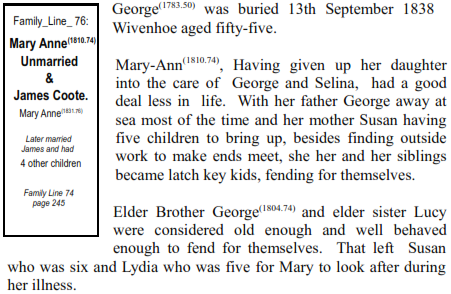
Mary-Ann(1810.74) was mainly looked after by her grandmother Mary. When grandmother Mary was taken ill in 1821, Mary-Ann(1810.74) , barely eleven years old, was farmed out in turn to neighbours: Mrs Lucas, who looked after her for for thirteen weeks, Mrs Ladbrook, for eighteen weeks and Mrs Dowdeswell for thirteen weeks.346 To be moved three times in so short a time begs the question as to Mary-Ann's behaviour. Did she inherit an attention deficit disorder or was she just a difficult child? All this happened while father George was on a long haul at sea. Was it just lack of a stable family? Unfortunately, we can only speculate.
Small wonder then, when Mary-Ann(1810.74) was little more than twenty, she found herself in trouble. In 1831 Oct 29th a voluntary examination of Mary-Ann(1810.74) Limmer, revealed she was expecting a child. Later that year, James Coote, late of Colchester was named as the father. The court granted a warrant of payment for the child. Mary Ann(1831.76) was born Dec 29th 1831 and on Jan 21st 1832, Mary-Ann(1810.74) was called for examination again.
James Coote appears to continue contact with Mary-Ann(1810.74) but did not marry her straight away347 That is how it came about, almost immediately after March 4th 1832, when Mary Ann(1831.76) was baptised, she was handed over to be brought up by uncle George(1804.74) and Auntie Selina348. James Coote and Mary-Ann(1810.74) eventually got together as a couple and we find them ten years later, (and just four miles up river at Hythe Quay), in the parish of St Leonard, Colchester. As a family, both they and the rest of their children settled, all were eventually buried in St Leonard's Churchyard.
George(1804.74), on the other hand, a fit and healthy seaman for most of his life, never settled at home. He continued to go to sea until he died at sea aged 72 in 1876. On Tuesday 7th March, he sailed out as a Kitchen hand on the Gem of the Ocean, but in the afternoon he felt ill. Taking a bit of bread and cheese and a glass of whiskey to his bunk he slept for eleven hours and died in his sleep 349.
Lydia(1817.74), the youngest daughter of George and Susan, followed the footsteps of her sister Mary-Ann. She was aged 26 and unmarried when she had twins George and Lucy Limmer. Born 17th March 1844, both twins died in 1845. The father was one William Hartley.
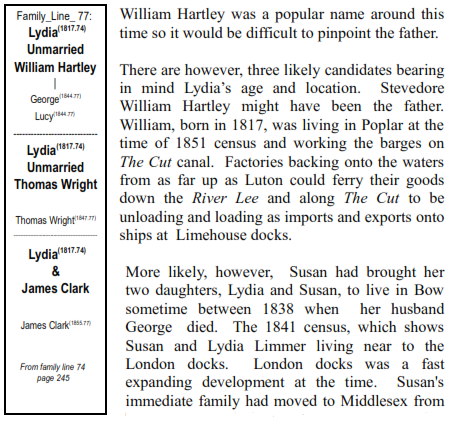
Thorington, so it is a natural assumption that Susan uprooted and move to Bow to be near them. Since the new docks had opened in 1928, Billingsgate had become the centre of the fishing industry for the south because larger fishing boats were able to get down the Thames river than could ever navigate the estuary to Wivenhoe. The Rose family had been Fishmongers all of their lives, Now Susan and Lydia had joined them in the business.
Here we meet the second and most likely suspected. William Hartley lived in Southwark street. He was two years younger than Lydia. Living round the corner to where Lydia and her mother Susan settled after the death of her father George, Lydia may have met William Hartley of Southwark by 1843. William was 27 years old in 1845 and as evidence suggests, worked as a labourer at Billingsgate fish market.350 William, born in 1820 had lived within a few streets of the market all his life.
One other William Hartley might fit the bill, but it is doubtful. William Hartley, the owner of a pub in St Margaret, Westminster was thirty three years old and married at the time Lydia gave birth to the twins. It is conceivable that Lydia had worked as a domestic or barmaid for a while, but I do not think it so. It is far more probable that Lydia moved straight to London with her mother and settled there. We will have to wait for more evidence to turn up before the real William Hartley stands up to take responsibility.
In the 1834 poor law reform, unmarried mothers were made solely responsible for their children. Mothers could not apply to a poor house for refuge nor could they seek maintenance from the father. You will be forgiven if you despair at the intelligent thinking of parliament then as much as you may today. It was said that this law would stop women being promiscuous. Surely the clever men, (for men it was though not so clever), could have worked out that males would have less reason to act responsibly. Of course the number of unmarried mothers rose rapidly by 1844 and so this law had been repealed under the outcry of society.
The twins, George and Lucy Hartley, were born after the passing of amendment to this act. Lydia does not seem to have sought compensation from William Hartley. As the twins died, it would not have made much difference anyhow. It may have been that she had not heard of the amended act, (as the working classes hardly ever knew what was going on in parliament), it may have been she did not have the means to pursue maintenance or, it may have been stubborn nature inherited from the genes of Susan. Having grown up in the fish business,351 (like mother like daughter), Susan set out to support herself and her family.
Lydia(1817.74), at the age of 30, is still unmarried when son Thomas Wright(1847.77) Limmer is born on the 13th April 1847. The father this time was a Thomas Wright.
Once again we have difficulty in identifying the right father. There are a dozen of them living in Middlesex. Five in Stepney, three in Hackney, three in Bethnal green and two in Poplar. If we exclude those outside of a five mile radius, those under twenty-five or over forty, one who was a vagrant and one other who was said to be a 'molly' ,352 we are left with three possible subjects, all married. One Thomas Wright, born in Scotland in 1817, came down from the north and married to Caroline Wright. He was living in Hackney St John and was working in the fish market. He becomes the chief suspect.
Another, married to Mary Wright, born 1816, also living in Hackney . The third, born 1816, Living in Hackney, was married to Jane Wright, but he left no further clues for us to know if he should be included or not.353
Lydia Limmer finally married James Clark on the 9th November 1851 at Bethnal Green. James Clark, from Saffron Walden, born 1826, was 25 years old. Lydia being 34 years of age when she married and 39 years old when the Clarks had a son James Clark, half brother to Thomas Wright Limmer born in 1855. Thomas' birth certificate and death certificate bear the name Limmer while his marriage certificate bears the name Thomas Wright Limmer. The Clarks settled down to family life and as far as the neighbours knew they simply had two sons Thomas and James Clark.
Thomas used the name Clark for most of his life and he can be found under this name in all the censuses until 1881. James Clark died in 1879. In the 1881 census, Lydia is described as widow and the head of the family, living at 1 Parnham Street354. Thomas Wright took his mother’s surname-Limmer- after that and never changed it again. This is clear by his marriage certificate in 1865. He married Susannah as Thomas Wright Limmer. His death certificate also bears the surname Limmer Susannah died in 1880 and Thomas returned home to help his mother in the fishmonger business, 355
Lydia(1817.74) died 1st May 1893 Stepney at the age of 76.
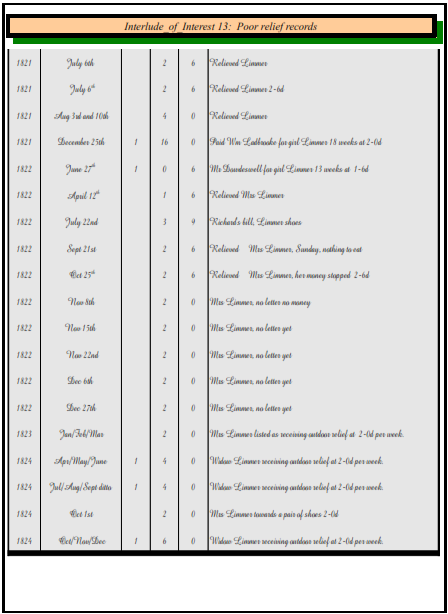
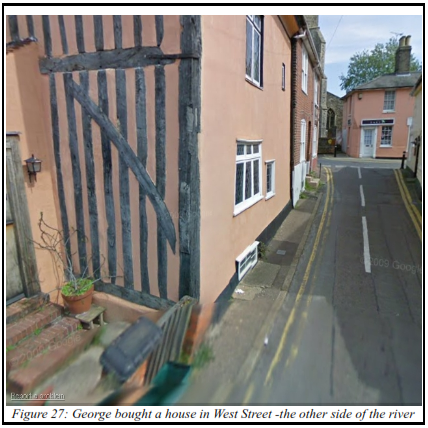




 aving met Edward (1737.46) and Mary Caldecott in part three, chapter 17, we can follow their children.
aving met Edward (1737.46) and Mary Caldecott in part three, chapter 17, we can follow their children.






